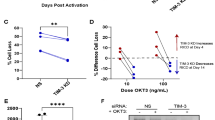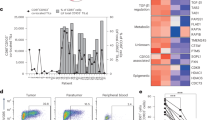Abstract
Here we show that apoptotic cells overexpress vinculin and are ingested by dendritic cells, which subsequently cross-prime vinculin-specific cytotoxic T lymphocytes (CTLs). Successful cross-priming requires that the apoptotic cells provide maturation signals to dendritic cells through CD40–CD40 ligand (CD40L) interactions. If apoptotic cells are CD40L−, the help of a third T cell is needed for priming, indicating a regulatory role for apoptotic cells in determining priming or tolerance. Vinculin-specific CTL priming is also related to apoptosis in vivo, given that in HIV-seropositive individuals, the frequency of specific CTLs depends on the proportion of peripheral CD40L+ apoptotic cells.
This is a preview of subscription content, access via your institution
Access options
Subscribe to this journal
Receive 12 print issues and online access
$209.00 per year
only $17.42 per issue
Buy this article
- Purchase on Springer Link
- Instant access to full article PDF
Prices may be subject to local taxes which are calculated during checkout





Similar content being viewed by others
References
Bevan, M.J. Cross-priming for a secondary cytotoxic response to minor H antigens with H-2 congenic cells which do not cross-react in the cytotoxic assay. J. Exp. Med. 143, 1283–1288 (1976).
Albert, M.L., Sauter, B. & Bhardwaj, N. Dendritic cells acquire antigen from apoptotic cells and induce class I-restricted CTLs. Nature 392, 86–89 (1998).
Heath, W.R. & Carbone, F.R. Cytotoxic T lymphocyte activation by cross-priming. Curr. Opin. Immunol. 11, 314–318 (1999).
Inaba, K. et al. Efficient presentation of phagocytosed cellular fragments on the major histocompatibility complex class II products of dendritic cells. J. Exp. Med. 188, 2163–2173 (1998).
Carbone, F.R., Kurts, C., Bennett, S.R., Miller, J.F. & Heath, W.R. Cross-presentation: a general mechanism for CTL immunity and tolerance. Immunol. Today 19, 368–373 (1998).
Barnaba, V., Franco, A., Alberti, A., Benvenuto, R. & Balsano, F. Selective killing of hepatitis B envelope antigen-specific B cells by class I-restricted, exogenous antigen-specific T lymphocytes. Nature 345, 258–260 (1990).
Rock, K.L. A new foreign policy: MHC class I molecules monitor the outside world. Immunol. Today 17, 131–137 (1996).
Watts, C. Capture and processing of exogenous antigens for presentation on MHC molecules. Annu. Rev. Immunol. 15, 821–850 (1997).
Yewdell, J.W., Norbury, C.C. & Bennink, J.R. Mechanisms of exogenous antigen presentation by MHC class I molecules in vitro and in vivo: Implications for generating CD8+ T cell responses to infectious agents, tumors, transplants, and vaccines. Adv. Immunol. 73, 1–77 (1999).
Regnault, A. et al. Fc-γ receptor-mediated induction of dendritic cell maturation and major histocompatibility complex class I-restricted antigen presentation after immune complex internalization. J. Exp. Med. 189, 371–380 (1999).
Castellino, F. et al. Receptor-mediated uptake of antigen/heat shock protein complexes results in major histocompatibility complex class I antigen presentation via two distinct processing pathways. J. Exp. Med. 191, 1957–1964 (2000).
Matzinger, P. Tolerance, danger, and the extended family. Annu. Rev. Immunol. 12, 991–1045 (1994).
Banchereau, J. & Steinman, R.M. Dendritic cells and the control of immunity. Nature 392, 245–252 (1998).
Sallusto, F., & Lanzavecchia, A. Mobilizing dendritic cells for tolerance, priming, and chronic inflammation. J. Exp. Med. 189, 611–614 (1999).
den Haan, J.M.M., Lehar, S.M., & Bevan, M.J. CD8+ but not CD8− dendritic cells cross-prime cytotoxic T cells in vivo. J. Exp. Med. 192, 1685–1695 (2000).
Reid, S.D., Penna, G., & Adorini, L. The control of T cell responses by dendritic cell subsets. Curr. Opin. Immunol. 12, 114–121 (2000).
Gallucci, S., Lolkema, M. & Matzinger, P. Natural adjuvants: endogenous activators of dendritic cells. Nature Med. 5, 1249–1255 (1999).
Ronchetti, A. et al. Immunogenicity of apoptotic cells in vivo: role of antigen load, antigen-presenting cells, and cytokines. J. Immunol. 163, 130–136 (1999).
Sauter, B. et al. Consequences of cell death. Exposure to necrotic tumor cells, but not primary tissue cells or apoptotic cells, induces the maturation of immunostimulatory dendritic cells. J. Exp. Med. 191, 423–434 (2000).
Steinman, R.M., Turley, S., Mellman, I. & Inaba, K. The induction of tolerance by dendritic cells that have captured apoptotic cells. J. Exp. Med. 191, 411–416 (2000).
Restifo, N.P. Building better vaccines: how apoptotic cells death can induce inflammation and activate innate and adaptive immunity. Curr. Opin. Immunol. 12, 597–603 (2000).
Limmer, A. et al. Efficient presentation of exogenous antigen by liver endothelial cells to CD8+ T cells results in antigen-specific T-cell tolerance. Nature Med. 6, 1348–1354 (2000).
di Marzo Veronese, F. et al. Autoreactive cytotoxic T lymphocytes in human immunodeficiency virus type 1-infected subjects. J. Exp. Med. 183, 2509–2516 (1996).
Sercarz, E.E. et al. Dominance and crypticity of T cell antigenic determinants. Annu. Rev. Immunol. 11, 729–766 (1993).
Barnaba, V. Viruses, hidden self-epitopes and autoimmunity. Immunol. Rev. 152, 47–66 (1996).
Pantaleo, G. & Fauci, A.S. New concepts in the immunopathogenesis of HIV infection. Annu. Rev. Immunol. 13, 487–512 (1995).
Cutrona, G. et al. Expression of CD10 by human T cells that undergo apoptosis both in vitro and in vivo. Blood 94, 3067–3076 (1999).
Lane, P. et al. Activated human T cells express a ligand for the human B cell-associated antigen CD40 which participates in T cell-dependent activation of B lymphocytes. Eur. J. Immunol. 22, 2573–2578 (1992).
Scognamiglio, P. et al. Presence of effector CD8+ T cells in hepatitis C virus-exposed healthy seronegative donors. J. Immunol. 162, 6681–6689 (1999).
Cerundolo, V. et al. The proteasome-specific inhibitor lactacystin blocks presentation of cytotoxic T lymphocyte epitopes in human and murine cells. Eur J. Immunol. 27, 336–341 (1997).
Finkel, T.H. et al. Apoptosis occurs predominantly in bystander cells and not in productively cells of HIV- and SIV-infected lympho nodes. Nature Med. 1, 129–134 (1995).
Muro Cacho, C.A., Pantaleo G. & Fauci A.S. Analysis of apoptosis of HIV-infected persons. Intensity of apoptosis correlates with the general state of activation of the lymphoid tissue and not with stage of disease or viral burden. J. Immunol. 154, 5555–5566 (1995)
Badley, A. D. et al. In vivo analysis of Fas/FasL interactions in HIV-infected patients. J. Clin. Invest. 102, 79–87 (1998)
Rosen, A., Casciola-Rosen, L. & Ahearn, J. Novel packages of viral and self-antigens are generated during apoptosis. J. Exp. Med. 181, 1557–1561 (1995).
Mevorach, D., Zhou, J.L., Song, X. & Elkon, K.B. Systemic exposure to irradiated apoptotic cells induces autoantibody production. J. Exp. Med. 188, 387–392 (1998).
Cella, M. et al. Ligation of CD40 on dendritic cells triggers production of high levels of interleukin-12 and enhances T cell stimulatory capacity: T-T help via APC activation. J. Exp. Med. 184, 747–752 (1996).
Gauchat, J.F. et al. Induction of human IgE synthesis in B cells by mast cells and basophils. Nature 365, 340–343 (1993).
Carbone, E. et al. A new mechanism of NK cell cytotoxicity activation: the CD40–CD40 ligand interaction. J. Exp. Med. 185, 2053–2060 (1997).
Henn, V. et al. CD40 ligand on activated platelets triggers an inflammatory reaction of endothelial cells. Nature 391, 591–594 (1998).
Bennett, S.R. et al. Help for cytotoxic-T-cell responses is mediated by CD40 signalling. Nature 393, 478–480 (1998).
Ridge, J.P., Di Rosa, F. & Matzinger, P. A conditioned dendritic cell can be a temporal bridge between a CD4+ T-helper and a T-killer cell. Nature 393, 474–478 (1998).
Schoenberger, S.P., Toes, R.E., van der Voort, E.I., Offringa, R. & Melief, C.J. T-cell help for cytotoxic T lymphocytes is mediated by CD40–CD40L interactions. Nature 393, 480–483 (1998).
Sallusto, F. & Lanzavecchia, A. Efficient presentation of soluble antigen by cultured human dendritic cells is maintained by granulocyte/macrophage colony-stimulating factor plus interleukin 4 and downregulated by tumor necrosis factor alpha. J. Exp. Med. 179, 1109–1118 (1994).
Prezzi, C. et al. Virus-specific CD8+ T cells with type 1 or type 2 cytokine profile are related to different disease activity in chronic hepatitis C virus infection. Eur. J. Immunol. 31, 894–906 (2001).
Dunbar, P.R. et al. Direct isolation, phenotyping and cloning of low-frequency antigen-specific cytotoxic T lymphocytes from peripheral blood. Curr. Biol 8, 413–416 (1998).
Acknowledgements
We thank F. Di Rosa for discussions and critical reading of the manuscript and C. Mastroianni for providing us the HIV-infected patients. This work was supported by Ministero della Sanità-Istituto Superiore di Sanità (Progetti AIDS 1998 to V.B. and M.F., and Epatite Virale 1997 to V.B.).; Ministero dell'Università e della Ricerca Scientifica e Tecnologica 40% 1997–1998 to V.B.; Progetto Associazione Italiana Sclerosi Multipla (AISM) 1997–1998 to V.B.; Progetto Finalizzato CNR 'Biotecnologie' to V.B.; European Community Contract No. BMH4-CT98-3703 to V.B.; and Associazione Italiana per la Ricerca sul Cancro (AIRC) 1999 to M.F.
Author information
Authors and Affiliations
Corresponding author
Rights and permissions
About this article
Cite this article
Propato, A., Cutrona, G., Francavilla, V. et al. Apoptotic cells overexpress vinculin and induce vinculin-specific cytotoxic T-cell cross-priming. Nat Med 7, 807–813 (2001). https://doi.org/10.1038/89930
Received:
Accepted:
Issue Date:
DOI: https://doi.org/10.1038/89930
This article is cited by
-
CD8+ T cells specific for cryptic apoptosis-associated epitopes exacerbate experimental autoimmune encephalomyelitis
Cell Death & Disease (2021)
-
The immune system view of the coronavirus SARS-CoV-2
Biology Direct (2020)
-
Context-Dependent Role of Vinculin in Neutrophil Adhesion, Motility and Trafficking
Scientific Reports (2020)
-
Combination of chemotherapy and PD-1 blockade induces T cell responses to tumor non-mutated neoantigens
Communications Biology (2020)
-
Crossreactivity to vinculin and microbes provides a molecular basis for HLA-based protection against rheumatoid arthritis
Nature Communications (2015)



